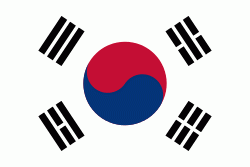Yangyang International Airport (Yangyang International Airport)
Yangyang International Airport is a small international airport in northeastern South Korea. It is located in Yangyang County, Gangwon Province and was built to serve the nearby areas of Sokcho, Gangneung, and Pyeongchang. The airport replaced Gangneung and Sokcho airports.
In 2011, 5,748 passengers used the airport.
Air Koryo operated charters from Sondok Airport to Yangyang Airport during 2002–2006 for few months per year. Flights were halted indefinitely after relations soured between the two Koreas.
Yangyang International Airport handled its last flight on 1 November 2008, according to the Korea Airport Corporation, and there were calls for it to be sold off or closed. It reopened on 16 July 2010 when East Asia AirLine started flying to Busan.
On 4 August 2011, Taiwan's TransAsia Airways began flying to Yangyang International Airport (five times a week). TransAsia Airways stated that it will be a regular chartered service. However, on the 18th of February 2017, TransAsia Airways went into liquidation.
With Pyeongchang being voted as the host city for 2018 Winter Olympics, Yangyang International Airport hopes to see an increase in passengers. Korean Air scheduled additional charter flights from Yangyang to Europe and North America, including New York–JFK, Minneapolis–St. Paul, London–Gatwick, and Munich.
This includes a visa-free grace for the Philippines, Indonesia, and Vietnam so long as citizens land in Yangyang. VietJet Air is the only airline carrier that operates flights from South East Asia to Yangyang (charter flights from Hanoi to Yangyang).
In 2011, 5,748 passengers used the airport.
Air Koryo operated charters from Sondok Airport to Yangyang Airport during 2002–2006 for few months per year. Flights were halted indefinitely after relations soured between the two Koreas.
Yangyang International Airport handled its last flight on 1 November 2008, according to the Korea Airport Corporation, and there were calls for it to be sold off or closed. It reopened on 16 July 2010 when East Asia AirLine started flying to Busan.
On 4 August 2011, Taiwan's TransAsia Airways began flying to Yangyang International Airport (five times a week). TransAsia Airways stated that it will be a regular chartered service. However, on the 18th of February 2017, TransAsia Airways went into liquidation.
With Pyeongchang being voted as the host city for 2018 Winter Olympics, Yangyang International Airport hopes to see an increase in passengers. Korean Air scheduled additional charter flights from Yangyang to Europe and North America, including New York–JFK, Minneapolis–St. Paul, London–Gatwick, and Munich.
This includes a visa-free grace for the Philippines, Indonesia, and Vietnam so long as citizens land in Yangyang. VietJet Air is the only airline carrier that operates flights from South East Asia to Yangyang (charter flights from Hanoi to Yangyang).
Map - Yangyang International Airport (Yangyang International Airport)
Map
Country - South_Korea
 |
 |
| Flag of South Korea | |
The Korean Peninsula was inhabited as early as the Lower Paleolithic period. Its first kingdom was noted in Chinese records in the early 7th century BCE. Following the unification of the Three Kingdoms of Korea into Silla and Balhae in the late 7th century, Korea was ruled by the Goryeo dynasty (918–1392) and the Joseon dynasty (1392–1897). The succeeding Korean Empire (1897–1910) was annexed in 1910 into the Empire of Japan. Japanese rule ended following Japan's surrender in World War II, after which Korea was divided into two zones; a northern zone occupied by the Soviet Union and a southern zone occupied by the United States. After negotiations on reunification failed, the southern zone became the Republic of Korea in August 1948 while the northern zone became the communist Democratic People's Republic of Korea the following month.
Currency / Language
| ISO | Currency | Symbol | Significant figures |
|---|---|---|---|
| KRW | South Korean won | â‚© | 0 |
| ISO | Language |
|---|---|
| EN | English language |
| KO | Korean language |















